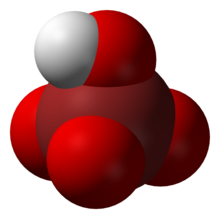Perbromic acid
Appearance

| |
| Identifiers | |
|---|---|
3D model (JSmol)
|
|
| ChEBI | |
| ChemSpider | |
PubChem CID
|
|
CompTox Dashboard (EPA)
|
|
| |
| |
| Properties | |
| BrHO4 | |
| Molar mass | 128.91 |
| Melting point | decomposes before melting, unstable as solid |
| Hazards | |
| Occupational safety and health (OHS/OSH): | |
Main hazards
|
powerful oxidizer |
Except where otherwise noted, data are given for materials in their standard state (at 25 °C [77 °F], 100 kPa).
| |
The compound perbromic acid is the inorganic compound with the formula HBrO4. It is an oxoacid of bromine. Perbromic acid is unstable and cannot be formed by displacement of chlorine from perchloric acid, as periodic acid is prepared; it can only be made by protonation of the perbromate ion.
Perbromic acid is a strong acid and strongly oxidizing. It is the least stable of the halogen(VII) oxoacids. It decomposes rapidly on standing to bromic acid and oxygen. It reacts with bases to form perbromate salts.
See also
Further reading
- Appelman, Evan H. (1969). "Perbromic acid and perbromates: synthesis and some properties". Inorganic Chemistry. 8 (2): 223. doi:10.1021/ic50072a008.
